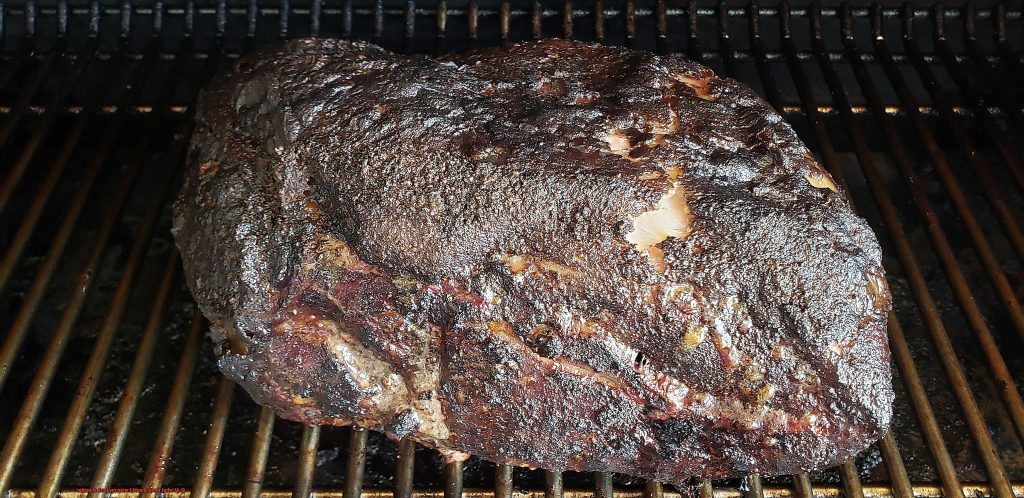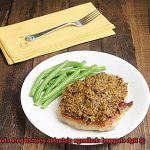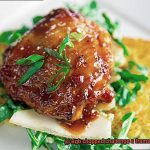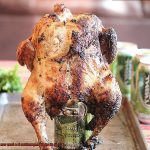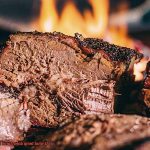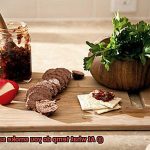The mere thought of slow-cooking this flavorful cut sends my taste buds into a frenzy. But here’s the thing, my fellow pitmasters and home cooks: when should we wrap our pork shoulder?
Wrapping it up is like giving it a cozy blanket, locking in all that moisture and tenderness. It’s the secret to achieving pork perfection.
So, let’s get down to business and answer the burning question: at what temperature should we wrap our beloved pork shoulder? In this blog post, we’re diving deep into the world of pork shoulder cooking.
Whether you’re a seasoned grill master or just starting out on your backyard cooking journey, buckle up and prepare to discover the ultimate solution to this juicy dilemma.
Contents
What is the ‘Texas Crutch’?
This game-changing technique, born in the heart of Texas, holds the key to achieving mouthwateringly juicy and tender pork shoulder on your grill. In this article, we’ll explore the origins, purpose, execution, and temperature considerations of the Texas Crutch. Get ready to impress your guests with barbecue that will have them begging for your secret recipe.
Origins and Purpose:
The Texas Crutch earned its name from its widespread use in the world of Texas-style barbecue. As pitmasters and backyard grillers marveled at the exceptionally moist and tender meat produced by this technique, it became an integral part of their repertoire. The primary objective of the Texas Crutch is twofold: to retain the natural juices of the pork shoulder and to speed up the cooking process.
Execution:
To execute the Texas Crutch, start by smoking the pork shoulder uncovered for several hours. This allows the meat to absorb that coveted smoky flavor and develop a crispy outer layer known as the bark. Once this initial phase is complete, it’s time to wrap the meat tightly in either foil or butcher paper. This wrap creates a sealed environment that allows the meat to cook in its own juices, breaking down collagen and connective tissues for ultimate tenderness.
Temperature Considerations:
Timing is everything when it comes to wrapping your pork shoulder. Many pitmasters opt to wrap when the internal temperature reaches around 160-170°F (71-77°C). At this point, the meat has absorbed enough smoke and formed a delightful bark, making it prime for wrapping. However, some pitmasters prefer slightly higher temperatures (170-175°F) to enhance the smoky flavor, while others prefer lower temperatures (150-155°F) for a softer bark and more delicate smoke infusion. Experimentation with different temperatures will help you find the perfect balance that suits your barbecue preferences.
What Temperature Should I Wrap My Pork Shoulder?
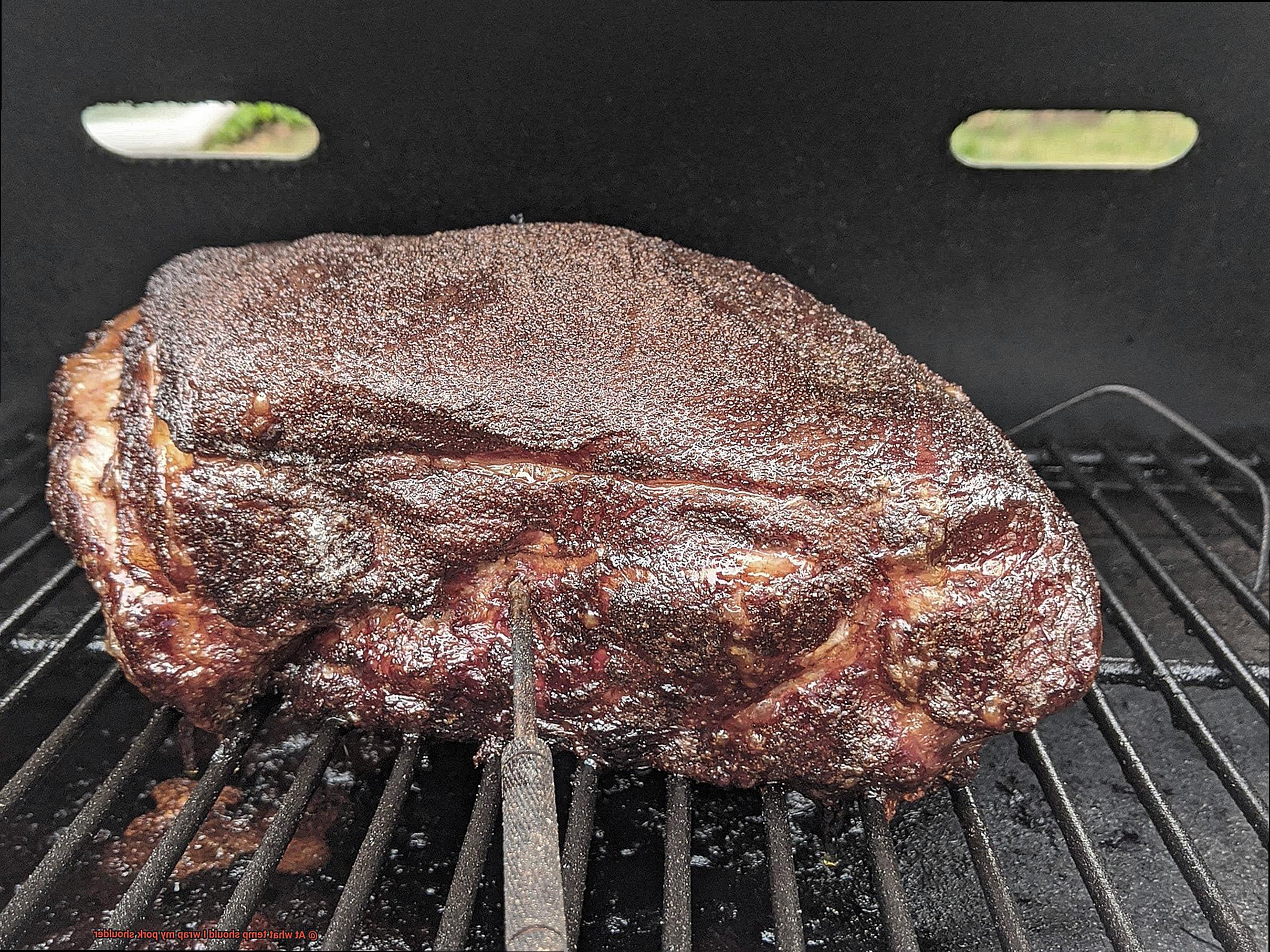
Imagine sinking your teeth into a tender, succulent pork shoulder, perfectly cooked on your grill. The secret to achieving such culinary bliss lies in knowing when to wrap it. In this article, we will delve into the world of pork shoulder wrapping, exploring the ideal temperatures for various cooking methods and personal preferences. Whether you are a seasoned pitmaster or an avid backyard griller, get ready to elevate your culinary game to new heights.
Low and Slow Cooking Methods:
For those who swear by the age-old low and slow cooking methods, such as smoking or slow-roasting, the golden rule is to wrap your pork shoulder when it reaches an internal temperature of around 160-165°F (71-74°C). At this point, your meat has absorbed the smoky goodness and developed a beautiful crust on the outside. Wrapping it helps retain moisture and enhances tenderness while preventing excessive evaporation.
Early Wrapping:
However, if you are looking to speed up the cooking process or achieve a more consistent texture throughout, some pitmasters prefer wrapping their pork shoulder as early as 140-150°F (60-66°C). This method reduces overall cooking time and yields a slightly firmer texture. But beware. Wrapping too early may limit smoke absorption. Finding the perfect balance is key.
The Crispy Bark Lovers:
If you crave that mouthwatering crispy exterior, leaving your pork shoulder unwrapped throughout the entire cooking process is the way to go. As your meat cooks, it develops a dark crust known as bark, which adds incredible crunch and intense flavor. However, be vigilant. Extended unwrapped cooking increases the risk of drying out. Regular basting or mopping will help retain moisture while achieving that coveted bark.
Finding Your Perfect Wrap Temperature:
Ultimately, the ideal wrap temperature depends on your personal preference and desired texture. Are you after melt-in-your-mouth tenderness or a firm yet succulent bite? Experiment with different wrapping techniques and temperatures to discover what suits your taste buds best. Grilling is an art, and finding your own signature style is part of the fun.
Benefits of Wrapping at 160-165°F (71-74°C)
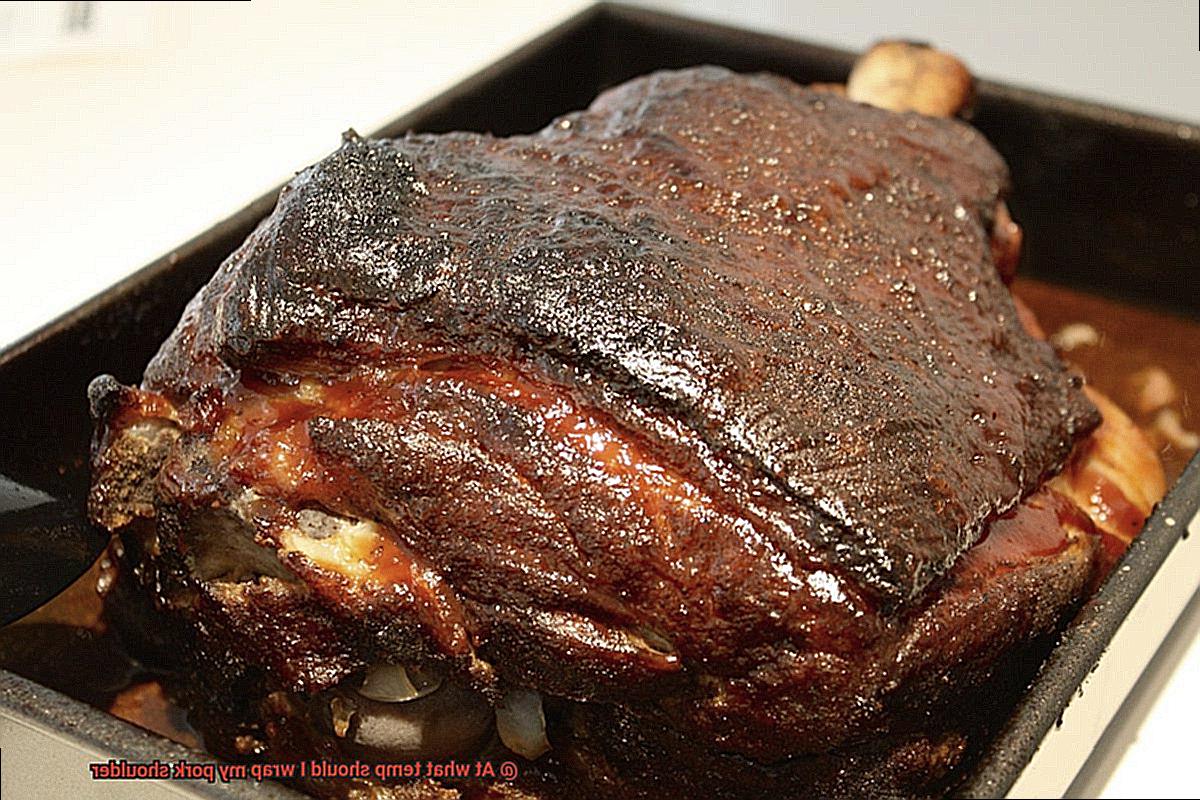
Unleashing the Juicy Goodness: The Benefits of Wrapping Pork Shoulder at 160-165°F (71-74°C)
Calling all grill masters and backyard enthusiasts. Want to take your pork shoulder game to the next level? We have a secret weapon for you – wrapping it at the perfect temperature. Get ready to elevate your grilling experience and impress your friends and family with tender, juicy, and flavorful meat.
Enhanced Moisture Retention:
Imagine sinking your teeth into a perfectly cooked pork shoulder bursting with juices. By wrapping it at 160-165°F (71-74°C), you create a moisture-trapping cocoon. Every bite is tender and succulent as the collagen breaks down, locking in those flavorful juices.
Faster Cooking Time:
Patience is key, but time is not always on our side. Wrapping at the recommended temperature range can be a game-changer. The trapped heat and moisture expedite the cooking process, so you can enjoy your meal sooner. Handy when cooking for a crowd or with time constraints.
Improved Bark Formation:
That beautiful crust on the exterior of your pork shoulder adds texture and flavor. Wrapping at 160-165°F (71-74°C) achieves the perfect balance between tenderness and bark formation. The meat develops a rich bark while remaining moist and tender on the inside.
Tender Meat Texture:
Nobody wants tough and chewy meat. Wrapping at the recommended temperature range gives it a ticket to tenderness heaven. Connective tissues break down, resulting in a melt-in-your-mouth texture, whether you prefer pulled pork or sliced perfection.
Enhanced Flavor Infusion:
Ready to amp up the flavor game? Wrapping allows for optimal flavor infusion. The meat cooks in its own juices within the wrap, absorbing all the goodness from seasonings, herbs, or marinades applied earlier. A mind-blowing flavor profile that is well-balanced throughout every bite.
Reduced Risk of Drying Out:
No more worrying about overcooking and drying out your prized pork shoulder. Wrapping creates a protective barrier that prevents excessive moisture loss. Achieve a succulent and juicy final result every time.
Pros and Cons of Wrapping at Higher Temperatures
Wrapping your pork shoulder at higher temperatures might just be the secret to achieving mouthwatering, tender, and juicy results. But before you fire up the grill, let’s dive into the pros and cons of this cooking technique.
First and foremost, let’s talk about the advantages. Wrapping your pork shoulder tightly in foil or butcher paper and cooking it at higher temperatures can help speed up the cooking process. The intense heat created inside the wrap helps break down the connective tissues and fats in the meat faster, resulting in a more tender and succulent final product. Plus, it helps develop a beautiful bark on the outside of the pork shoulder – that irresistible crust that adds texture and flavor.
Another advantage of wrapping at higher temperatures is moisture retention. The tight seal created by the wrap traps in the natural juices of the pork shoulder, preventing them from evaporating during cooking. This means a more delicious and flavorful end result that will leave your taste buds dancing with joy.
And let’s not forget about time-saving. Wrapping at higher temperatures can significantly reduce the overall cooking time. So if you’re short on time or have hungry guests eagerly waiting for their meal, this method can be a real lifesaver.
But as with any cooking technique, there are also some potential drawbacks to consider. One concern is that the higher heat can cause the exterior of the meat to become overly browned or even burnt. This can affect both the appearance and taste of your dish, which might not be ideal if you’re aiming for presentation perfection.
Additionally, wrapping at higher temperatures may limit the amount of smoke flavor that penetrates the meat. When cooked at lower temperatures without wrapping, the meat has more exposure to the smoke from the grill or smoker, giving it that distinct smoky flavor that many barbecue enthusiasts crave.
Another consideration is the risk of overcooking or drying out the pork shoulder. While wrapping does help retain moisture, it’s crucial to monitor the internal temperature of the meat closely to ensure it reaches a safe and optimal level of doneness without becoming dry.
Ultimately, the decision to wrap at higher temperatures depends on your personal preference and desired outcome. If you prioritize convenience and faster cooking time, then this method might be a great fit for you. However, if you’re all about that deep smoke flavor and a more traditional barbecue experience, you might want to stick with lower temperatures and skip the wrapping.
Pros and Cons of Wrapping at Lower Temperatures
Today, we’re diving into the pros and cons of wrapping a pork shoulder at lower temperatures when smoking. So grab your apron and let’s explore the world of low-temperature wrapping.
Advantages of Wrapping at Lower Temperatures:
- Moisture Retention: By wrapping the pork shoulder, you create a sealed environment that traps in the natural juices. This slow and steady cooking process helps preserve moisture, resulting in a tender and juicy end product that will have your taste buds begging for more.
- Enhanced Smoky Flavor: Cooking at lower temperatures allows the pork shoulder to spend more time in the smoker, allowing the smoke to penetrate deeper into the meat. This extended exposure to smoky goodness enhances the flavor profile, delivering a rich and complex taste that will leave your guests amazed.
Disadvantages of Wrapping at Lower Temperatures:
- Prolonged Cooking Time: The lower temperature means it takes longer for the pork shoulder to reach the desired level of tenderness. If you’re pressed for time or have hungry guests eagerly waiting, this could be a potential downside.
- Softer Bark: Wrapping at lower temperatures may result in a softer bark, that flavorful crust on the outside of the meat. While some prefer this tender texture, others crave that satisfying contrast between the crispy bark and succulent meat.
- Less Pronounced Smoke Ring: Wrapping at lower temperatures can limit exposure to smoke, potentially affecting the development of a smoke ring—a pink discoloration just beneath the surface highly prized among grilling aficionados.
Conclusion:
In the end, whether you choose to wrap your pork shoulder at lower temperatures or not depends on your personal preferences and desired outcomes. Wrapping can help retain moisture and intensify the smoky flavor, but it may also extend cooking time and alter the texture of the bark. Don’t be afraid to experiment and find the technique that suits your taste buds best.
Tips for Wrapping Your Pork Shoulder
If you want to impress your friends and family with a mouthwatering pork shoulder, you’ve come to the right place. Wrapping your pork shoulder is a crucial step that will lock in all the flavors and juices, leaving you with a tender and juicy final product. In this guide, we’ll walk you through the steps to achieve grilling perfection. Let’s get started.
The Ideal Temperature for Wrapping:
When grilling your pork shoulder, aim to wrap it around 160-165°F (71-74°C). This is when the meat reaches the stall, a point where the temperature plateaus. Wrapping at this stage helps to speed up cooking while ensuring your pork stays moist and flavorful.
Choosing the Right Wrap:
For wrapping, you have two excellent options: aluminum foil and butcher paper. Aluminum foil seals in all the heat and moisture, resulting in a succulent pork shoulder. Butcher paper allows some airflow, creating a crispy bark on the outside while retaining juiciness. The choice is yours.
Seasoning for Flavor:
Before wrapping, make sure to add your favorite seasonings or sauces to enhance the taste of your pork shoulder. Rub on some dry spices or brush on a marinade for maximum flavor infusion.
Wrapping Techniques:
With aluminum foil, create a tight seal to trap steam and keep your meat moist. For butcher paper, wrap tightly but allow some space for airflow. Both methods will result in juicy perfection.
Reaching the Desired Temperature:
Return your wrapped pork shoulder to the grill until it reaches an internal temperature of 195-205°F (90-96°C). This ensures that connective tissues break down, resulting in tender and juicy pulled pork.
Resting for Maximum Flavor:
Remove your wrapped pork shoulder from the grill and let it rest for about 30 minutes. This allows the juices to redistribute throughout the meat, resulting in maximum flavor and tenderness.
Alternatives to Wrapping Your Pork Shoulder
Your quest for culinary excellence ends here. Discover a plethora of alternatives to wrapping that will take your pork shoulder to unprecedented levels of scrumptiousness.
First on our list of alternative methods is the tantalizing dry rub. Picture this – a blend of spices and seasonings artfully applied directly to the pork shoulder before cooking. The result? A symphony of flavors that permeates every morsel, creating a mouthwatering crust on the outside of the meat. Say goodbye to the need for wrapping as you savor a perfectly seasoned pork shoulder.
Now, let’s turn our attention to basting – an absolute game-changer in the world of grilling. This technique involves periodically brushing or pouring liquid over the pork shoulder as it cooks. Whether you opt for a luscious marinade, tangy barbecue sauce, or simply pure water or broth, basting ensures that the meat remains moist and teeming with flavor. As the liquid reduces and caramelizes on the surface of the meat, it imparts an irresistible layer of deliciousness.
For those with time on their side, slow cooking offers an unparalleled alternative. Envision a low-temperature cooking process that allows the pork shoulder to transform into a state of unparalleled tenderness and juiciness. Whether employing a slow cooker, oven, or grill with indirect heat, this method ensures that the natural juices within the pork shoulder are retained, offering an extraordinary end product that will leave your taste buds dancing with delight.
Last but certainly not least, we present the transformative power of marinating. Immerse your pork shoulder in a harmonious concoction of oil, acid (such as vinegar or citrus juice), herbs, and spices. Watch in awe as the meat absorbs these exquisite flavors, while simultaneously being tenderized to perfection. The longer you marinate, the bolder the flavors become, culminating in a pork shoulder that will leave your guests begging for your secret recipe.
J3u60gScW-A” >
Conclusion
In conclusion, wrapping your pork shoulder is an absolute game-changer when it comes to achieving a mouthwateringly tender and flavor-packed masterpiece. Picture this: the ideal temperature for wrapping hovers around 160-165°F (71-74°C), right at that magical moment when the meat hits the stall and soaks up just enough smoke to create a tantalizing bark. Wrapping it up at this stage is like giving your pork shoulder a big, cozy hug that locks in all that precious moisture and takes tenderness to new heights.
Now, let’s dive into the juicy details of different methods and temperatures for wrapping your pork shoulder. If you’re all about that low and slow cooking style, then wrapping at 160-165°F (71-74°C) is your ticket to meaty nirvana. This technique preserves every drop of moisture while cranking up those smoky flavors to eleven. But hey, if time is of the essence or you crave a consistent texture throughout, don’t be afraid to wrap as early as 140-150°F (60-66°C) – it can work wonders.
But hold on tight, because there’s another option for all you crispy bark enthusiasts out there. You can choose to leave your pork shoulder unwrapped throughout the entire cooking process – just remember to give it some love with regular basting or mopping to keep it from drying out.
Now here’s where things get interesting: wrapping at higher temperatures can actually speed up cooking time and deliver melt-in-your-mouth tenderness. Plus, it creates an oh-so-glorious crust on the outside that will have your taste buds doing a happy dance. But beware, my friend – there are trade-offs. You might sacrifice some of that smoky goodness and risk overcooking or drying out your precious pork.
On the flip side, wrapping at lower temperatures is like taking a deep dive into flavor town. It locks in moisture like nobody’s business and lets that smoky goodness penetrate every nook and cranny. Just keep in mind that it might take a bit longer to cook, and the bark might be on the softer side.
At the end of the day, finding your perfect wrap temperature is a personal journey filled with mouthwatering experiments. So go ahead, fire up that grill or smoker, treat your pork shoulder with the utmost care, and prepare yourself for a culinary masterpiece that will leave you craving more.

